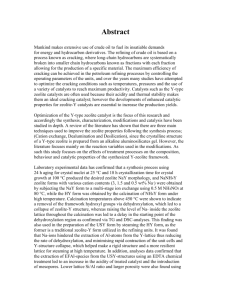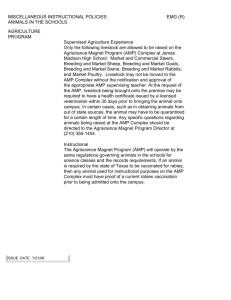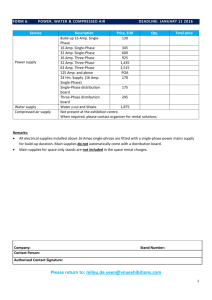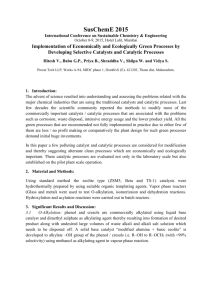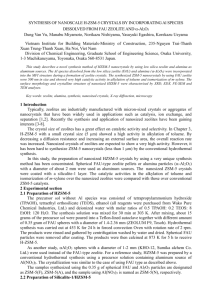(pyridine adsorption method). It can be seen, by referring, Fig 2 that
advertisement
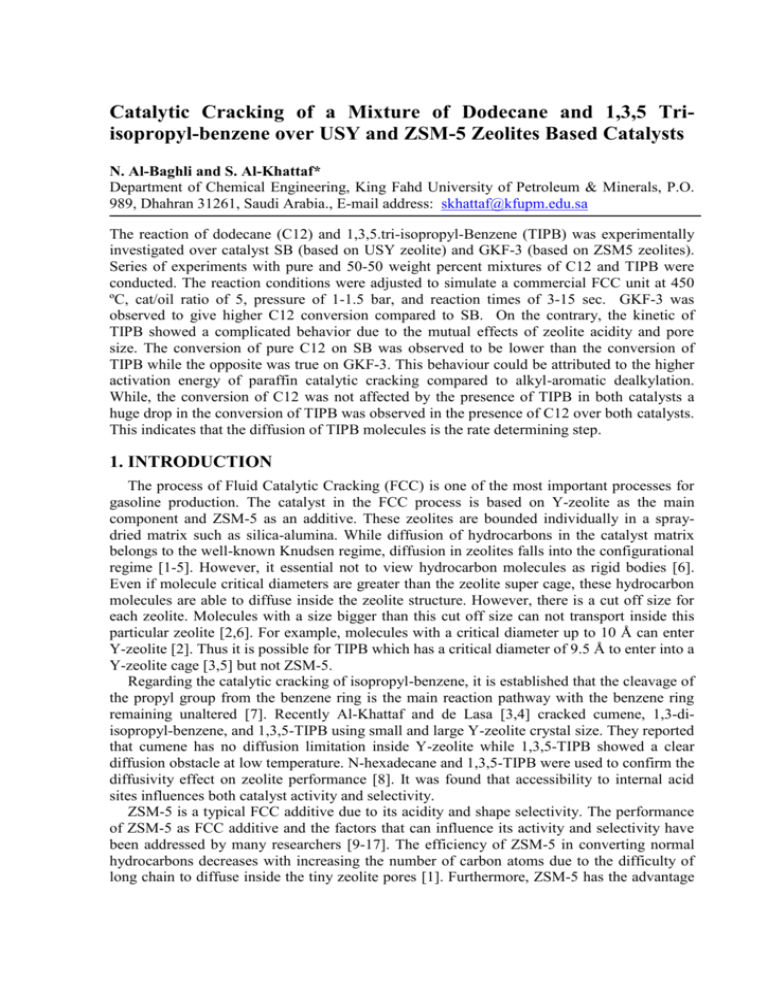
Catalytic Cracking of a Mixture of Dodecane and 1,3,5 Triisopropyl-benzene over USY and ZSM-5 Zeolites Based Catalysts N. Al-Baghli and S. Al-Khattaf* Department of Chemical Engineering, King Fahd University of Petroleum & Minerals, P.O. 989, Dhahran 31261, Saudi Arabia., E-mail address: skhattaf@kfupm.edu.sa The reaction of dodecane (C12) and 1,3,5.tri-isopropyl-Benzene (TIPB) was experimentally investigated over catalyst SB (based on USY zeolite) and GKF-3 (based on ZSM5 zeolites). Series of experiments with pure and 50-50 weight percent mixtures of C12 and TIPB were conducted. The reaction conditions were adjusted to simulate a commercial FCC unit at 450 ºC, cat/oil ratio of 5, pressure of 1-1.5 bar, and reaction times of 3-15 sec. GKF-3 was observed to give higher C12 conversion compared to SB. On the contrary, the kinetic of TIPB showed a complicated behavior due to the mutual effects of zeolite acidity and pore size. The conversion of pure C12 on SB was observed to be lower than the conversion of TIPB while the opposite was true on GKF-3. This behaviour could be attributed to the higher activation energy of paraffin catalytic cracking compared to alkyl-aromatic dealkylation. While, the conversion of C12 was not affected by the presence of TIPB in both catalysts a huge drop in the conversion of TIPB was observed in the presence of C12 over both catalysts. This indicates that the diffusion of TIPB molecules is the rate determining step. 1. INTRODUCTION The process of Fluid Catalytic Cracking (FCC) is one of the most important processes for gasoline production. The catalyst in the FCC process is based on Y-zeolite as the main component and ZSM-5 as an additive. These zeolites are bounded individually in a spraydried matrix such as silica-alumina. While diffusion of hydrocarbons in the catalyst matrix belongs to the well-known Knudsen regime, diffusion in zeolites falls into the configurational regime [1-5]. However, it essential not to view hydrocarbon molecules as rigid bodies [6]. Even if molecule critical diameters are greater than the zeolite super cage, these hydrocarbon molecules are able to diffuse inside the zeolite structure. However, there is a cut off size for each zeolite. Molecules with a size bigger than this cut off size can not transport inside this particular zeolite [2,6]. For example, molecules with a critical diameter up to 10 Å can enter Y-zeolite [2]. Thus it is possible for TIPB which has a critical diameter of 9.5 Å to enter into a Y-zeolite cage [3,5] but not ZSM-5. Regarding the catalytic cracking of isopropyl-benzene, it is established that the cleavage of the propyl group from the benzene ring is the main reaction pathway with the benzene ring remaining unaltered [7]. Recently Al-Khattaf and de Lasa [3,4] cracked cumene, 1,3-diisopropyl-benzene, and 1,3,5-TIPB using small and large Y-zeolite crystal size. They reported that cumene has no diffusion limitation inside Y-zeolite while 1,3,5-TIPB showed a clear diffusion obstacle at low temperature. N-hexadecane and 1,3,5-TIPB were used to confirm the diffusivity effect on zeolite performance [8]. It was found that accessibility to internal acid sites influences both catalyst activity and selectivity. ZSM-5 is a typical FCC additive due to its acidity and shape selectivity. The performance of ZSM-5 as FCC additive and the factors that can influence its activity and selectivity have been addressed by many researchers [9-17]. The efficiency of ZSM-5 in converting normal hydrocarbons decreases with increasing the number of carbon atoms due to the difficulty of long chain to diffuse inside the tiny zeolite pores [1]. Furthermore, ZSM-5 has the advantage 2 of low deactivation tendency compared to the other zeolites [22]. Recently, Corma et al [23] have observed that the addition of ZSM-5 to the FCC commercial catalyst has improved significantly the octane number and the C3-C4 olefins of the FCC gasoline. The objective of this paper was to study the catalytic performance of ZSM-5 and USYzeolites in cracking of TIPB and n-dodecane using the Riser Simulator. The study also investigated the role of diffusion on conversion of these molecules. The catalytic cracking of these compounds is of great interest because of its potential industrial applicability. 2. EXPERIMENTATION 2.1 Apparatus All experimental runs were carried out in the riser simulator. This reactor is novel bench scale equipment with internal recycle unit invented by de Lasa [23]. A complete description of this unit can be found in work by Kraemer [27]. The products were analyzed in an Agilent 6890N gas chromatograph with a flame ionization detector and a capillary column INNOWAX, 60-m cross-linked methyl silicone with an internal diameter of 0.32 mm. 2.2 Materials Both ZSM-5 and Y-zeolite were provided by Tosoh Co. The as-synthesized Na zeolite was ion exchanged with NH4 NO3 to replace the Na cation with NH4+. Following this, NH3 was removed and the H form of the zeolite was spray-dried using kaolin as the filler and a silica sol as the binder. The resulting 60 μm catalyst particles had the following composition: 30 wt % zeolite, 50 wt % kaolin, and 20 wt % silica. The process of Na removal was repeated for the pelletized catalyst. Following this, the catalyst was calcined at 600oC for 2 h. Finally, the fluidizable SB catalyst particles (60 μm average size) were treated with 100% steam at 810 oC for 6 h. GKF-3 catalysts were not treated with steam. 2.3 Catalyst Characterization The BET surface area was measured according to the standard procedure ASTM D-3663 using Sorptomatic 1800 Carlo Erba Strumentazione unit, Italy. The acid property of the catalyst was characterized by NH3 temperature-programmed desorption (NH3-TPD). In all the experiments, 50 mg of sample was outgassed at 400 oC for 30 min. in flowing He and then cooled down to 100 oC. At that temperature, NH3 was adsorbed on the sample by injecting pulses of 2 µl/pulse. The injection was repeated until the amount of NH3 detected was the same for the last two injections. After the adsorption of NH3 was saturated, the sample was flushed at 100 oC for 1 h. with He to remove excess NH3, and then the temperature was programmed at 10 oC /min up to 850 oC in flowing helium at 30 ml/min. Flame ionization detector was used to monitor the desorbed NH3. 3. RESULTS AND DISCUSSION 3.1 Catalyst Characterization The physico-chemical properties of the catalysts used in this study are presented in Table 1. Figure 1 shows the NH3-TPD for the two catalysts. This figure reveals the total amount of acidity of each catalyst. It can be shown that the non-steamed GKF-3 catalyst has almost 8 times more acidity than SB catalyst. The ratio of Lewis acid sites and Bronsted acid sites was measured by FTIR (pyridine adsorption method). It can be seen, by referring, Fig 2 that the steamed SB catalyst has more Lewis acidity than Bronsted acidity. However, comparable amount of both acid types was measured for the non-steam GKF-3 catalyst. 3 Figure 1. TPD of ammonia profiles of the catalysts. Figure 2. FTIR spectra of pyridine adsorption of the catalysts. 4 Table 1. Characterization of Used Catalysts Acidity Lewis Bron Surface Area Catalyst (mmol/g) sites % sites % (m2/g) Type GKF-3 0.233 44 56 70 ZSM-5 Negligible SB 0.03 65 35 150 Y-Zeolite Negligible Catalyst Na2O wt % 3.2 Conversion of TIPB and C12 The experimental results are reported as plots of conversion of C12 and TIPB versus reaction time. All the experiments were carried out at 450 ºC, cat/oil ratio of 5, and pressure of 1 bar. The reactor effluent was analysed at reaction times of 3, 5, 7, 10, and 15 sec. A comparison of the conversion of pure C12 over GKF-3 and SB is shown in Figure 3. It was observed that for both zeolites, the C12 conversion increases, as expected, with increase in reaction time (5-15 s). At low reaction time both zeolites seem to have the same conversion. However, as the reaction time continues to increase the difference in C12 conversion also increases. It is clear from Figure 3 that the conversion of C12 is higher in GKF-3 than in SB. At reaction time of 15 sec, the C12 conversion over GKF-3 is almost double that over SB. The higher activity of GKF-3 is attributed to its high acidity compared to SB bearing in mind the small size of C12 molecules. On the contrary, the kinetic behaviour of pure TIPB is more complicated than that of C12 as shown in Figure 4. It appears that both the acidity and the pore size of both zeolites have a significant role to play. It is depicted from Figure 4. that the TIPB conversion over both zeolites overlaps. It is well known that TIPB can not penetrate inside the GKF-3 structure, thus it has to react on the external acid site (only 3 % of the total acid sites). On the other hand, SB has larger pores (steaming at 810 ºC for 6 hr can create large pores). It is quite clear that each zeolite used in the present study has an advantage over the other when TIPB was used as feedstock. This explains why both catalysts have similar conversion. 30 % C o n v ersio n % C o n v ersio n 30 20 20 10 10 SB G K F -3 SB G K F -3 0 0 0 5 10 15 20 0 5 10 15 20 T im e / sec T im e / sec F ig u re 3. C o n v ersion of p u re C 1 2 o n G K F -3 an d S B F ig u re 4. C o n version o f p u re T IP B o n G K F -3 an d S B 5 The conversion of pure C12 is higher than the conversion of TIPB over GKF-3 (Figure 5) while the opposite is true over SB (Figure 6). This behaviour can be interpreted based on the higher activation energy of cracking reaction of paraffines in comparison to the corresponding dealkylation reaction of alkyl aromatics in addition to the effect of catalyst acidity and pore size. The interaction of C12 and TIPB over both catalysts has been studied by injecting the reactor with a feed that contains equal amounts of both components. The results are compared to the pure feed runs. As shown in Figure 7 and Figure 8, the conversion of C12 is not affected by the presence of TIPB over both zeolites. In contrast, the conversion of TIPB has substantially decreased in the presence of C12 in both catalysts (Figure 9 and Figure 10). It appears that the C12 molecules which have substantially higher diffusivity than the TIPB molecules occupy the active sites faster leaving fewer active sites available for the TIPB molecules. This is an indication that the diffusion is the rate determining step. 30 % C o n v ersio n % C o n v ersio n 30 20 20 10 10 C 12 T IP B 0 0 5 10 15 C 12 T IP B 0 20 0 5 T im e / sec 10 15 20 T im e / sec F ig u re 5. C o n version o f p u re C 1 2 an d p u re T IP B o n G K F -3 F ig u re 6 . C o n version o f p u re C 1 2 an d p u re T IP B o n S B 25 30 % C o n versio n % C o n versio n 20 20 15 10 10 F eed: 100 % C 12 F eed: 50 % C 12 + 50 % T IP B 0 5 F eed : 10 0 % C 1 2 F eed: 50 % C 12 + 50 % T IP B 0 0 4 8 12 T im e / sec 16 F ig u re 7. C o n version o f C 1 2 o n G K F -3 20 0 4 8 12 T im e / sec 16 F ig u re 8. C o n version o f C 1 2 o n S B 20 6 3.3- Product Distribution. 30 30 20 20 % C o n v ersio n % C o n v ersio n Cracking of C12 was observed to produce mainly gases on both catalysts. No aromatic compounds were detected by cracking pure C12. However, The final main products obtained by cracking 1,3,5 TIPB are gases (mainly propylene) and benzene. The intermediate cracking products were cumene and di-iso-propylbenzene (DIPB) isomers. Recently Mohgoub and AlKhattaf [28] discussed cracking of pure C12 and 1,3,5 TIPB on FCC catalyst based on ZSM-5 and USY zeolites. It was found that the catalyst based on ZSM-5 (with high acidity) crack C12 more efficiently than catalyst based on USY-zeolite (with low acidity). It is well known that 1,3,5 TIPB catalytic cracking undergoes a series of three steps namely; 1) dealkylation of 1,3,5 TIPB into DIPB isomers and propylene, 2) dealkylation of DIPB into cumene and propylene, and 3) dealkylation of cumene into benzene and propylene [4]. These compounds were detected in cracking both pure 1,3,5 TIPB and mixture of C12 and 1,3,5 TIPB. Besides these three dominant products, other products have been detected like ethylbenzene, xylenes, and toluene. These compounds are the product of the cracking of the propyl group attached to the benzene ring. Regarding gases, it is difficult to determine their sources because they can be produced from the cracking of both C12 1,3,5 TIPB. It was observed that the benzene selectivity is higher for the mixture feed than that of the pure 1,3,5 TIPB even though pure C12 cracking does not produce any aromatics at the present reaction conditions. For both catalysts mixing C12 with 1,3,5 TIPB increased the benzene selectivity. This result can be interpreted based on the low aromatic concentration when mixture feed is used, which enhances all the 1,3,5 TIPB cracking steps. As a result, the yield of the product gases and benzene increased. Furthermore, Table 2 shows clearly the high yield of TEX (toluene, ethylbenzen and xylenes) for the mixture feedstock. Other products are essentially cumene, DIPB (products of intermediate step catalytic cracking), 1,3,5 TIPB isomers and some heavy compounds. Referring to Tables 2 to 5, it seems mixing C12 to 1,3,5 TIPB did not have any significant effect on the yield of these compounds. 10 10 F eed : 10 0 % T IP B F eed : 50 % C 12 + 5 0 % T IP B 0 F eed : 10 0 % T IP B F eed : 50 % C 12 + 5 0 % T IP B 0 0 5 10 15 T im e / sec F ig u re 9. C o n version o f T IP B o n G K F -3 20 0 5 10 15 T im e / sec F ig u re 10 . C o nversio n o f T IP B o n S B 20 7 Table 2. Product Distribution for the Cracking of TIPB on GKF-3 Catalyst (Feed: 50 % TIPB + 50 % C12) Time/s 3 5 7 10 15 % Conversion of TIPB 7.02 9.62 12.50 16.14 22.01 % Yield of Benzene 1.70 2.60 3.40 3.72 5.00 % Yield of Cumene 0.16 0.24 0.34 0.42 0.56 % Yield of DIPB 0.30 0.50 1.02 2.00 3.12 % Yield of TEX 1.22 2.00 2.84 3.60 5.08 Table 3. Product Distribution for the Cracking of TIPB on GKF-3 Catalyst (Feed: Pure TIPB) Time/s 3 5 7 10 15 % Conversion of TIPB 7.30 14.00 18.30 20.10 24.50 % Yield of Benzene 1.10 2.50 3.30 3.90 4.60 % Yield of Cumene 0.20 0.78 0.82 1.20 1.30 % Yield of DIPB 0.10 0.91 1.20 2.20 3.10 % Yield of TEX 0.20 0.45 0.60 0.75 1.00 Table 4. Product Distribution for the Cracking of TIPB on SB Catalyst (Feed: 50 % TIPB + 50 % C12) Time/s 3 5 7 10 15 % Conversion of TIPB 5.50 8.90 12.50 17.50 24.89 % Yield of Benzene 1.72 3.00 4.00 5.42 7.40 % Yield of Cumene 0.42 0.86 1.50 2.40 4.00 % Yield of DIPB 0.00 0.00 0.12 0.28 0.44 % Yield of TEX 0.40 0.50 0.63 0.86 1.00 Table 5. Product Distribution for the Cracking of TIPB on SB Catalyst (Feed: Pure TIPB) Time/s 3 5 7 7’’ 10 % Conversion of TIPB 7.60 11.55 14.60 18.80 21.62 % Yield of Benzene 1.10 2.00 3.00 3.30 4.00 % Yield of Cumene 0.30 0.96 1.40 1.90 3.00 % Yield of DIPB 0.00 0.15 0.13 0.30 0.51 % Yield of TEX 0.10 0.30 0.40 0.40 0.53 8 4. CONCLUSIONS The cracking behaviour of C12 and TIPB was experimentally investigated over GKF-3 and SB catalysts. The conversion of pure C12 is higher than the conversion of TIPB over GKF-3 while the opposite is true over SB. The presence of C12 substantially affected the conversion of TIPB over both catalysts while the conversion of C12 remained unchanged. The diffusion of TIPB molecules is the rate determining step in its reaction over zeolites. ACKNOWLEDGEMENT The authors gratefully acknowledge King Fahd University of Petroleum & Minerals for the financial support provided for this work under project # 255. We also wish to thank Mr. Mariano Gica and Mr A. Iliyas for their useful collaboration on the experimental work under the same project. Special thanks are due to Dr Shakeel Ahmed for his invaluable assistance and suggestions on TPD measurement. REFERENCES [1] [2] [3] [4] [5] [6] [7] [8] [9] [10] [11] [12] [13] [14] [15] [16] [17] [18] [19] [20] [21] [22] [23] [24] [25] [26] [27] [28] Rossini, Stefano, Catalysis Today, 77, 2003, 467-484. Karger, J., & Ruthven, D.M. John Wiley & Sons, Inc. 1992. Al-Khattaf, S. Ph.D Dissertation, University of Western Ontario, London, Ontario, Canada, 2001. Al-Khattaf, S. & de Lasa, H. Applied Catalysis A General, 2002, 226, 139-153. Al-Khattaf, S.; Atias, J.A; Jarosch, K.; de Lasa, H. Chemical Engineering Science, 2002, 57, 4909. Xiao, J.; Wei, J. Chem Eng Sci. 1992, 47, 5, 1123-1141. Corma, A.; Wojciechowski, B.W. Cat. Rev. Sci. Eng. 1982, 24, 1, 1-65. Roos, K.; Liepoid, A.; Koch, H., and Reschetilowski, W. Chem. Eng . Technol. 1997, 20, 326332. Rajagopalan, K.; Young, G.W. Prepr.-Am. Soc., Div. Pet. Chem. 1987, 32, 3, 627. Biswas, J.; Maxwell, I. E. Appl. Catal. 1990, 58, 1. Madon,R. J. J. Catal. 1991, 129, 275. Elia, M. F. ; Iglesias, E.; Martinez, A.; Pascual, M.A. Appl. Catal. 1991, 73, 195. Miller,S. J.; Hsieh, C.R. Prepr.-Am. Chem. Soc. Div. Pet. Chem. 1990, 685. Nalbandian, L.; Vasalos, I.A.; Kasapaki, A.; Vassilakis, K. Prepr.Am. Chem. Soc., Div. Pet. Chem. 1993, 584. Guerzoni, F.N.; Abbot, J. Appl. Catal. A 1994, 120, 55. Nalbandian, I.; Lemonidou, A.A.; Vasalos, I.A. Appl. Catal. A. 1993, 105, 107. Donnelly, S.P.; Mizrahi, S.; Sparrell, P.T.; Huss, A. Jr; Schipper,P.H.; Herbst, J.A. Prepr.Am. Chem. Soc., Div. Pet. Chem. 1987, 32 (3), 621. Dwyer, J.; Rawlence, D.J. Catal . Today, 1997, 18, 487. Buchanan J.S. Catalysis Today, 2000, 55, 207-212. Biswas, J.; Maxwell, I.E. Applied Catalysis A, 1990, 63, pp 197-258. Aitani, A.; Yoshikawa, T.; Ino, T. Catalysis Today, 2000, 60, 111-117. Herrman, C.; Haas, J.; Fetting, F. Applied Catalysis, 1987, 35, 299-310. Corma, A.; Melo, F.; Sauvanaud, L.; Ortega, F. Applied Catalysis A: General 265, 2004, 195206. de Lasa, H.I. U.S. Pat. 5 102 628, 1992. Iliyas, A.; Al-Khattaf, S. Ind. Eng. Chem. Res., 43, 2004, 1349. Iliyas, A.; Al-Khattaf, S. Appl. Catal. A: Gen 269, 2004, 225-236. Kraemer, D.W. Ph.D. Dissertation, University of Western Ont., London, Canada, 1991. Mohgoub, K.; Al-Khattaf, S. Energy & Fuel (Accepted).

